Text
Resources
Gaudio, R. (1994). Sounding Gay: Pitch Properties in the Speech of Gay and Straight Men. American Speech, 69(1), 30-57. doi:10.2307/455948
Garfinkel, H. (1967). Passing and the managed achievement of sex status in an intersexed person, part 1. pp. 116-85
GusB1. Auntie Mame. YouTube, YouTube, (2007, August 17), www.youtube.com/watch?v=UPX4S5cNx_c
Lieberman, P., & Blumstein, S. (1988). Speech Physiology, Speech Perception, and Acoustic Phonetics (Cambridge Studies in Speech Science and Communication). Cambridge: Cambridge University Press. doi:10.1017/CBO9781139165952
Munson, B., McDonald, E. C., DeBoe, N. L., & White, A. R. (2006). The acoustic and perceptual bases of judgments of women and men's sexual orientation from read speech. Journal of Phonetics, 34(2), 202-240. https://doi.org/10.1016/j.wocn.2005.05.003
Philips, S. (1980). Sex Differences and Language. Annual Review of Anthropology, 9, 523-544. Retrieved from http://www.jstor.org/stable/2155746
Sachs, Jacqueline, Philip Lieberman, & Donna Erickson. (1973). Anatomical and cultural determinants of male and female speech. Language Attitudes: Current Trends and Prospects. Ed. Roger W. Shuy and Ralph Fasold. Washington, D.C.: Georgetown University Press, 74-84.
Sachs, Jacqueline. (1975). Cues to the identification of sex in children’s speech. Language and Sex: Difference and Dominance. Ed. Barrie Thorne and Nancy Henley. Rowley, MA: Newbury House Publishers Inc. 71-152.
Un1fy003. (2011, September 16). Louis C.K.-Gay people_Who gives a sh#$. Retrieved from https://www.youtube.com/watch?v=eb-JZSyhWSc
18 notes
·
View notes
Text
Conclusion
There are certainly dozens of factors that are taken into account when determining sexual orientation, specifically those of homosexual and self-identifying bisexual men. The phonetic qualities and pitch frequencies of an individual are not reliable indicators of a person’s sexual attraction to the opposite or the same gender, or both... at least not on their own.
Fundamental frequencies (f0), vowel formants, and the sibilant, negatively skewed sss sound are, as numerous academic journals and studies released in the last five decades suggest, key features that researchers should focus more on when delving further into what phonetic properties are key in uncovering the phenomenon of the uppity, effeminate “gay voice”, keeping in mind how social context of speech and gender constructs play a role in one’s self-identification and its consequential effect on their voice.
Until concrete evidence is unveiled in a new and up-to-date study void of errors involving potential bias, all linguists (and anyone, really) can do is make inferences based on existing evidence that may help shed more light on what exactly makes a man sound gay and thoroughly unravel the variable relationship between speech and social functions.
0 notes
Text
Biology & Body Language
Biology
The premise of biology influencing pitch is believed by many to be responsible for the differences in pitch heard between men and women when you consider that:
a male’s vocal cords are longer and thicker than a female’s, and
men have larger supra-laryngeal vocal tracts (responsible for level of articulation in speech) post-puberty.
On the other hand, Sachs, Lieberman and Erickson (86-88) argue that the same differences appear when listening to the voices of boys and girls who haven’t experienced puberty just yet. Prepubescent boys were also found to round their lips to achieve a resultant lowered formant frequency, or deeper-sounding voice, suggesting that pitch may be conditioned and learned through imitation of adult speech that corresponds to the child’s implied gender as a result of childhood socialization: this phenomenon is NOT a result of the biological differences. Differentiation in speech between male and female voices can derive from other features like formant frequencies (resonant frequencies in the waves that we create when producing sound), length of vowels (/eɪ/, /i/, /ɑɪ/, /oʊ/, /yu/), consonant production, the duration of the sibilant ‘S’, and tonality/degree of loudness.
Body Language and Hand Gestures
Using air quotes or other such hand gestures to emphasize a spoken word or word sequence, making a facial expression to express an emotion/feeling, averting or redirecting one’s gaze, and the bodily posture and stance whilst speaking are all co-verbal behaviors. These behaviors are deemed “communicative devices” with the intent to accentuate and call attention to specific information expressed in oral speech.
Indications of gender through verbalization are phonetic and result from not only social norms and expected behaviors, but the biological aspect concerning differences in the male and female vocal tracts as well. Though there is little information within academic literature that establishes a person’s gender identity being effectively communicated though various means of body language and gesturing, "... Other dimensions of body movement occur only variably, and it is the statistical pattern of the shape, intensity, and frequency of movement elements that conveys gender, as well as masculinity and femininity. Thus gestural patterns that accompany speech may be marked as male or female by the frequency, intensity, and form of finger and hand movements.” (Philips, 526, 527)

.
0 notes
Text
The “Lisp” | Sibilant /s/
Being a self-identifying bisexual myself, I have always pondered the phenomenon of lavender language, particularly the quintessential portrayal of gay men and how they sound overtly genteel across American media and television:
“[Such] ... stereotypes are also propagated in popular literature. For example, author David Sedaris recollects how the group of boys with whom he attended speech pathology as a child for an /s/ misarticulation appeared to be a ‘Future Homosexuals of America’ organization (Sedaris 2001). This is arguably an illustration of perhaps the most widely cited characteristic of [Gay/Lesbian/Bisexual] speech style, the ‘gay lisp’.”
Sedaris also notes in Me Talk Pretty One Day that the other boys in his speech class appeared more feminine than masculine, or “gayer” more so than straight. This example aids to further the notion that media’s portrayal of the gay stereotype and how it shapes the ideology of the “gay voice” in turn leads to the misjudgment of the voice as being some sort of error in or inability to speak the right way. Associate Professor of Linguistics at Stanford University, Robert Podesva, too, suggests that some California speech varieties sound basically identical to those of stereotypical characters as demonstrated in "valley girl, [...] stoner” flicks where the characters’ speech is used to categorize them as the fun, wild, ready-to-party type.
...
youtube
Another experiment (Munson, McDonald, DeBoe, & White) was conducted to measure the perceptions of sexual orientation based on read speech.
Forty-four speaking participants aged 18-40 (11 lesbian/bisexual-identifying women, 11 heterosexual women, 11 gay/bisexual-identifying men, and 11 heterosexual men) from the states of Minnesota, Iowa, Wisconsin, North Dakota, and South Dakota fluent in North American English were recruited.
The 44 speaking participants were split into four groups of 11, each given a subset of 12 words:
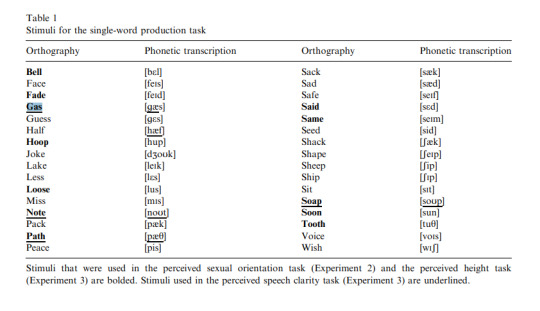
“[Each speaker] chose one of three words containing front vowels and sibilant fricatives (gas, said, same); three words with front vowels and no sibilant fricatives (bell, fade, path); three words with back-round vowels and sibilant fricatives (loose, soap, soon), and three words with back-round vowels and no sibilant fricatives (hoop, note, tooth).”
The 40 listening participants who were members of the University of Minnesota also fluent in English and aged 18-40 listened to the samples taken from each speaking participant and were asked to identify whether the speaker was gay or straight.
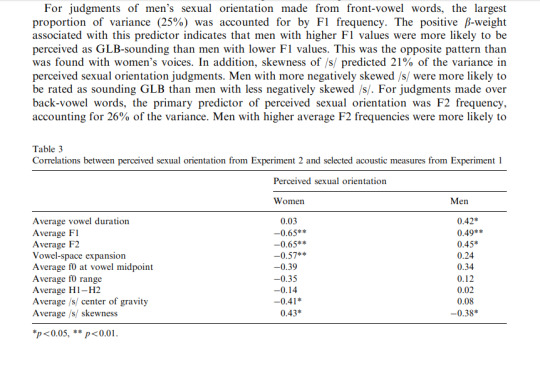

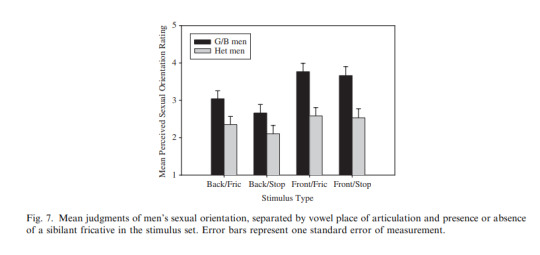
TL;DR: Gay, lesbian, and bisexual individuals were perceived as sounding more homosexual than their heterosexual counterparts according to the experiment. Regression analysis done by the research facilitators further examined the vocal parameters of G/B men and non-G/B men, suggesting that judgments made on a male’s sexual orientation were influenced significantly by the auditory skewed sibilant ‘S’ ... A.K.A. what many still refer to as the “gay lisp”!
0 notes
Text
The Stereotype
What do other members of the LGBTQA+ community think about the gay voice?
To find out more about the perceptions of the gay voice and where features such as shrillness and intonation associated with the voice stems from, I asked a few of my friends and old neighbors who consider themselves members of the LGBT community via an online questionnaire several things:
What is your perception on the gay voice?
What are some characteristics of the gay voice? (i.e. shrillness, up-speak, long consonant S, etc.)
Where do you think the gay voice stems from? Is someone born with it, or does it develop suddenly? Does the voice form over time?
Do you believe that you can make inferences on a man’s sexuality based solely on how he sounds? Why?
Kaleb, 25, identifies as a homosexual man
It is certainly easy to spot, especially if you’re a gay man. It is all just a matter of selective perception and bias, but all I have to say is that I find it exists much more so with flamboyantly gay and un-closeted homosexuals like me.
The long sss sound and high pitch are both a major giveaway, though using hand and other dramatized body gestures as you’re speaking could be an added characteristic.
I’d say that, at least in my case, it developed in my early adolescent years. It wasn’t until I realized that I was gay around age 11 that I started sounding a lot like my girl friends, who were really my only friends since I’d get picked on a lot for how I sounded “girly” by my male peers. Just about every other gay friend of mine and ex-boyfriends that I’ve had sounded quite a bit like me. The stereotype is pretty spot-on to me.
I believe it to be a product of social construct, trying to tie in the way somebody sounds with who and what they are attracted to. With this in mind, I think you can for sure at least pinpoint whether or not a man is gay and is not afraid to hide it if he sounds more feminine and less macho.
Doug, 47, identifies as a gay man
The gay voice is an affectation and tends to get rather annoying in groups.
The gay voice is characterized by nasal tones (head voice versus chest voice), drawn vowels, sibilant "s", up-speak, and a sing-song kind of tonality.
The gay voice is a learned one. David Thorpe’s 2014 documentary Do I Sound Gay? suggests the characteristics are those of females speaking, and boys who have spent a lot of time with women pick it up. I find it sounds a lot like actress Rosalind Russell in the 1958 comedy-drama "Auntie Mame". (04:12) In films of the 1950's, the voice indicated an urbane, witty, sophisticated person.
Straight men have the voice and gay men have the voice. It has absolutely no bearing on sexual orientation.
Kris, 21, identifies as a gay trans man
The voice is definitely a stereotyped way of speaking. That doesn’t mean it doesn’t exist, though. I hear it every year that I go to Dallas Pride tbh.
It’s the nasally, uppity, girly, Mean Girls sort of manner of speaking (for lack of a better term).
I think, as hormonal changes and puberty ensue, that the voice develops over time with little-to-no conscious awareness of the fact that such changes are taking place. It is difficult for some individuals to recall or figure out when they first sensed that they were somehow “different”.
Doing so would be insulting, but we make inferences based on how people look, what race they are, what gender they are (or were born as), how much they weigh, so how is it any different?
Zerek, 28, identifies as a bisexual man
The gay voice is a pronounced manner of speech used among gay and questioning men who are proud members within the community. I think every guy with even a subtle lisp or an ornate use of language are a littttttle gay.
Up-speak and elongated vowels coupled with a Bitchy tone make for the gay voice.
I’m guessing I’ve sounded like a bit of a queer, homo, what have you, since I was old enough to understand what it meant to be attracted to the same gender. I might have picked up on how girls speak since I lived with them, AKA my two sisters and mama. And I hung out with my ex-girlfriend back in middle school along with her friends and my best friend, Sammy. Plus I watched a lot of junk on t.v. like The Simple Life and Keeping Up With the Kardashians back then.
The only thing you can do is guess, and a lot of the time when it comes to trying to figure out if someone is gay, your guess is right. It’s rare to hear guys who aren’t gay that sound gay.
Based on the answers given by each of my respondents, the stereotypical gay voice is just that: a stereotype. It is unfair to make a judgement that a man is gay based solely on his manner of speaking, though some gay individuals themselves admit to making inferences as to what a guy’s sexual orientation is after hearing him speak.

(We all still do it, whether we like to admit it or not)
Identifying Gay Individuals via Phonetic Cues
A study conducted by linguists from the University of Ontario and the University of Toronto, Ron Smyth, Greg Jacobs and Henry Rogers, highlighted the various aspects and features of a male’s voice that listeners hone in on when gauging whether or not the person speaking is gay or straight. They collected a sample of voices (encompassing both straight-sounding and gay-sounding) from 25 male speaking-subjects aged 25-50 who were native speakers of Canadian English, with eight identifying as straight and the latter seventeen identifying as gay. Each subject read aloud a “scientific” passage about the history of rainbows to capture speech with little to no conveyed emotion in addition to a “dramatic” passage involving a story about an individual’s encounter with fire designed to look more at “... the phoneme /s/ as a stereotype that men draw upon to make their voices sound more gay”. Lastly, the subjects answered an open-ended question recalling a personal negative encounter they’ve had recently in an effort to collect a unique spontaneous sample. Each recording (3) of the speaking-subjects (25) spanned thirty seconds including a five-second pause for responses between each passage, yielding 75 speech samples.
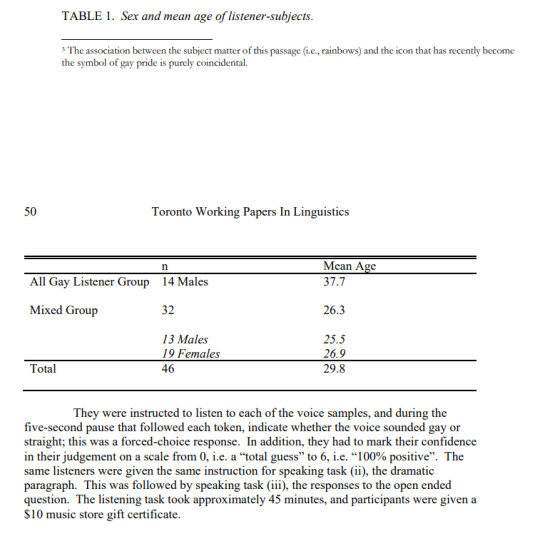
From here, a clip containing one sentence taken from each of the 75 samples was played for 46 listening-subjects with an overall mean age of 29.8. Of these 46, 14 explicitly self-identified as gay while the remaining 32 were a mix of an added 13 males and 19 females of undisclosed sexual orientation that the facilitators of the study presumed were heterosexual.
Of course, everyone’s voice has its own phonetic qualities making it different from others’ voices. The facilitators of this study found NO significant relationship or correlation between a speaker’s mean pitch range and the number of times he was thought of as “sounding gay”. They did, however, find that the voices of the men who were in fact gay-identifying sounded more gay to the listeners than the heterosexual-identifying speaking subjects across all three recorded modes of discourse. The gay men were especially believed to possess the gay voice with regards to their open-ended responses and the straight-talkers sounded much “gayer” as they read the scientific passage about rainbows.
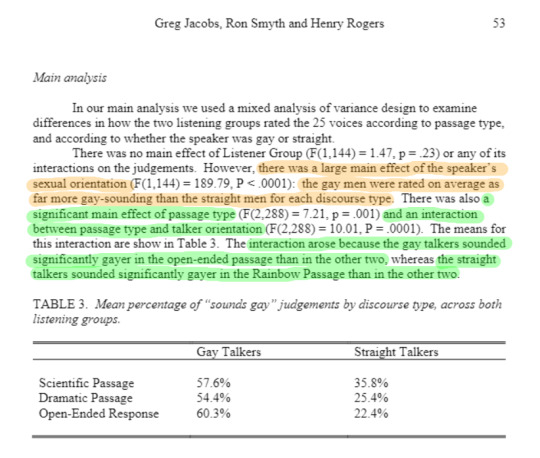
It is unclear, although I feel it is important to note that the 10.4%+ increase in straight men sounding gay when reading the Rainbow Passage versus the Scientific Passage and Open-Ended Response could be attributed to the association of certain words or terms (rainbow, for example) with social constructs of gender and other such labels regarding orientation. Reading the so-called Rainbow Passage might have made the speaking subjects subconsciously read the text in a stereotypical gay voice encompassing its key features like exaggerated variation of intonation and higher pitch.
Jacobs, Smyth and Rogers concluded that:
there is NO evidence to suggest “... Straight or masculine-sounding voices have a lower fundamental frequency than gay or less masculine-sounding voices—’, and
there is ‘...very limited evidence that these voices may be distinguished by some measures of pitch range and variability, depending on the speaking task.”
0 notes
Text
A Brief Intro
Welcome to this blog!

Hello there, and welcome to this nifty Tumblr page! My name is Amina Omeragic, and for my Un-Project for LING 4010, I have decided to delve into the origins of the stereotypical gay sounding voice using this web-based blogging platform.
Through rigorous research and collecting qualitative data, I've gathered information about the opinions of my peers who identify as members of the LGBTQA+ community, and those of pop culture celebrities as well as the findings (and viewpoints) of esteemed linguists regarding the gay male voice. Given the extensive nature of the research behind why the gay male voice exists and the topic of perceived sexual orientation based solely on how somebody sounds, I figured that a blog would be best in displaying the beliefs, and stereotypes, along with factual data concerning the phonetic characteristics of speech among gay men. Tumblr also seems to be a good medium to use in systematizing the factors at play which may influence or shape the gay voice of an individual.
Sexuality and the way a person sounds aren’t necessarily linked directly to one another, so why is it that men who identify as straight who speak with one or many of the same traits as a gay individual (i.e. shrillness, up-speak, elongated vowels, etc.) tend to be grouped in with society's ideology of what a gay man may sound like? How and when do gay individuals that possess this voice acquire it? Why?
0 notes